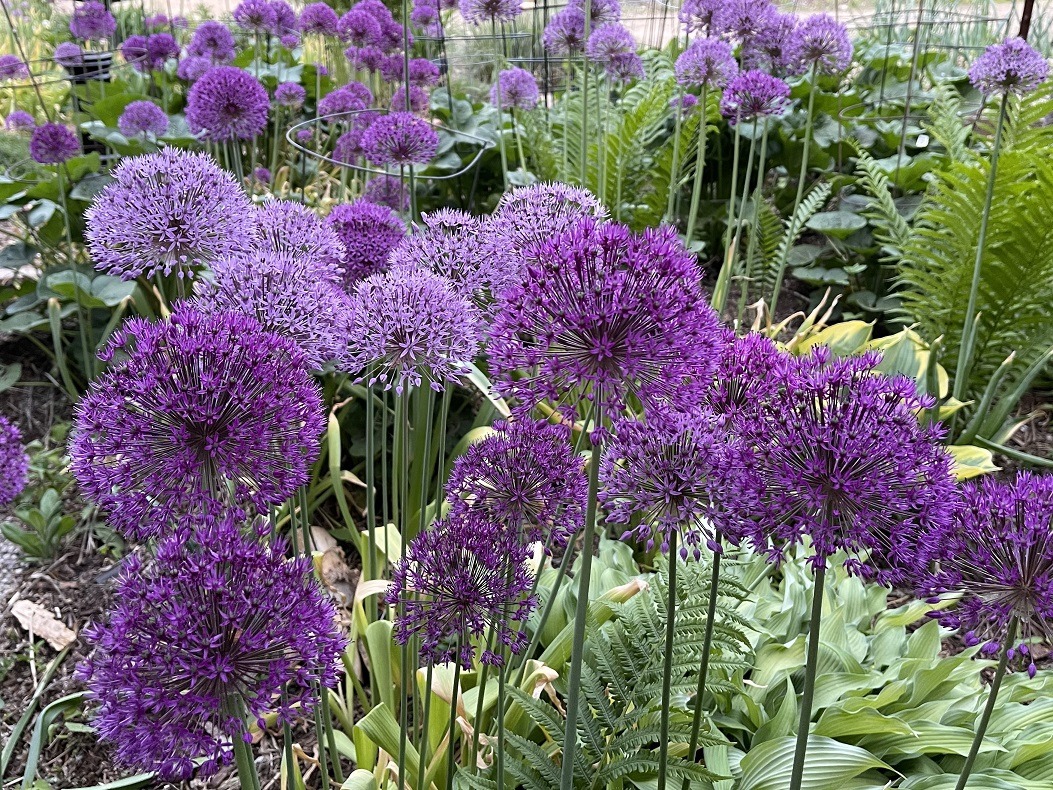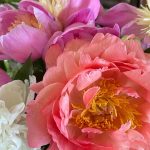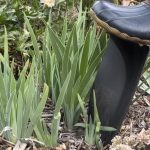As difficult as it is to think about, autumn is creeping up on us and the cooling weather of September and October is a perfect time to plant fall bulbs for an early spring flower show.
Knowing which bulbs to plant and the intricacies of planting bulbs in the fall can be tricky, and this blog seeks to simplify the these to ensure your garden is flourishing come spring!
This blog will cover:
- The difference between hardy bulbs and tender bulbs
- Which bulbs are hardy for zone 3 and zone 4 gardens
- What healthy bulbs look like
- Where to plant fall bulbs
- When to plant fall bulbs
- How to plant and establish fall bulbs
- How to care for fall bulbs in the spring
- And how to care for fall bulbs after they bloom
The Difference Between Hardy Bulbs and Tender Bulbs


Plants reproduce in several ways. Seed is likely the first way that comes to mind, but plants also reproduce by cuttings, rhizomes, tubers, fleshy roots, corms, and bulbs.

Let’s explore bulbs.
Bulbs are incredible plant structures that store the nutrients and framework for growing a new plant.
Because bulbs stay below the soil surface, they are uniquely protected from many adverse weather conditions, which ensures the viability of the next plant generation.
Genuine bulbs have five structures: a basal plate, scales (think onion), a tunic or skin, a shoot or eyes, and lateral buds.
Flowering bulbs are divided into two groups: Hardy Bulbs & Tender Bulbs.
Tender Bulbs are Often Referred to as Spring Bulbs
Spring bulbs are planted in the spring because they cannot tolerate our cold Canadian prairie winters.
Not all Spring bulbs are true bulbs. Callas and Lilies are, but Gladiolas grow from corms; and Begonias, Caladiums, and Dahlias emerge from tubers, like potatoes.
Spring bulbs are often started early indoors to give them a jump start on growing.
Hardy Bulbs are Also Called Fall Bulbs
Fall bulbs are called hardy bulbs because they can tolerate our winters and they are planted in autumn.
Fall Bulbs Require Two Things to Grow Successfully:
- Fall bulbs need time in autumn to get their roots established.
Strong and healthy roots are required to uptake water and nutrients in the spring to support flowering.
Fall bulb root development occurs when the soil temperature hovers around 10-15 C.
Other structures, like leaves and flower buds, also begin to form for spring flowering.
- Fall bulbs need a cold period (vernalization period) to initiate flowering.
Fall bulbs need a minimum of 10-13 weeks of cold below 4 C (40 F) – something we in Zone 3 have no problem accommodating!
Hardy Bulb Options for Growing Zones 3 & 4

Gardeners in growing zones 3 and 4 have a good selection of hardy bulbs available, and most of these types of bulbs have many varieties to choose from.
Related: What are Plant Hardiness Zones & How do They Work?
Let’s take a look at the bulb options for zones 3 and 4:
- Ornamental Alliums – provide round purple, pink, or white flower displays atop a stem anywhere from 25-100 cm (10–36″) tall. Depending on the variety, alliums are long-lived and don’t require frequent replanting. Most zone 3 and 4 hardy alliums are purple.
- Crocus – grow short 5-10 cm (2-4″) colorful flowers that often show up while there is still snow on the ground. They naturalize easily and don’t need replanting often. Crocus flowers close at night.
- Snowdrops (Galanthus) – are early blooming white drop-like flowers on short plants that go dormant in the heat of summer, plant these in groups of 10-25.
- Daffodils (Narcissus) – are delightful, frilly-edged, trumpet-shaped flowers that have a longer life span than most fall bulbs. If they get too thick, they will need to be divided as the foliage turns yellow. Deer also don’t like daffodils, Yay!
- Related: How to Grow Daffodils
- Hyacinth (Hyacinthus) – are short, fragrant, early spring flowering bulbs known for their clusters of bell-shaped flowers. Hyacinths are a good choice for Canadian gardens, pollinator, alpine, and rock gardens.
- Tulips – come in a massive array of colors and unique styles. Most tulips need to be replanted every 1-2 years. Tulips close up at night.
- Grape Hyacinth (Muscari) is a member of the lily family. This 10-15 cm (4-5″) tall plant bears blossoms that look like upright clumps of grapes above grassy-looking leaves. Give them a try in the front of a flowerbed, in alpine rock gardens, and woodland gardens. They come in shades of purple, white, and light blue.
Fall Bulbs Usually Bloom in this Order in Spring:
- Crocus & Snowdrops – as the snow is melting
- Daffodils & Hyacinths – in early to mid-May
- Tulips & Grape Hyacinth – mid to late May
- Alliums – bloom in late May and June
What Healthy Bulbs Look Like

Healthy bulbs are the foundation for beautiful blossoms and vigorous, vibrant plants, so selecting the right bulbs is essential.
Here are some tips to help you select the right bulbs for your garden:
- Healthy bulbs should feel firm like a potato.
- Bulbs shouldn’t be soft, squishy, oozy, or moldy.
- The outer skin (tunic) should be intact and firm against the bulb like an onion skin. Sometimes the tunic is rough, and other times it is smooth; it depends on the variety.
- Scratches or dents on the bulb’s exterior indicate that there has been some physical injury, and a break in the skin can be a vector for disease or infection.
Store fall bulbs in a cool dry place after purchasing and in the interim before they are planted to keep them from getting moldy.
The Best Garden Location for Fall Bulbs

Site Selection is one of the keys to growing great flowering fall bulbs. Choose a spot that will display the flowers well, has adequate light, rich soil, and good drainage.
Sunlight Requirements for Fall Bulbs
All bulbs need light and warmth to start the growing process.
Fall bulbs require a sunny location that gets at least 6-8 hours of sunshine.
It is okay to plant fall bulbs near deciduous trees that lose their leaves in autumn because they won’t be leafed out by the time the plants emerge in spring.
Bulbs will grow earlier and faster in warm south-facing areas than in shadier, cooler locations.
Soil & Drainage Requirements for Fall Bulbs
Bulbs grow best in good quality, loose, fertile soil that drains well because bulbs will rot when the soil stays damp.
Avoid planting bulbs in hard, clay-based soils because they drain poorly and retain moisture.
Other locations to bypass planting bulbs are wet areas or spots with standing water.
If the soil is hard, enrich it with organic components to soften it.
The Best Time to Plant Fall Bulbs

It is best to plant fall bulbs 5-6 weeks before the ground freezes solid, so different growing zones will plant at different times.
Approximate dates for planting fall bulbs in horticultural zones 1-4:
Zone 1 & 2: Early September
Zone 3: Mid-September
Zone 4: Late September / Early October
How to Plant Fall Bulbs
Planting fall bulbs properly is a combination of correct depth, spacing, watering, fertilizing, and mulching. Let’s briefly explore all of these elements.
How Deep Should Fall Bulbs be Planted?
The correct bulb planting depth depends on the type of bulb and the soil conditions.
The general rule of thumb with bulbs is to plant them at a depth roughly twice the bulb’s width.
Most packages will give precise measurements for the variety.
Plant fall bulbs at the recommended depth for soft and pliable soils, but for harder soils, plant a little shallower.
How to Space Fall Bulbs
Bulbs can be planted individually or in clusters.
Plant larger bulbs like Alliums, Daffodils, Hyacinths, and Tulips 15 cm (6″) apart, but smaller bulbs like Crocus & Grape Hyacinth can be as close as 5 cm (2″).
How to Prepare the Bulb Planting Site

Decide whether you would like to plant the bulbs in clusters or individually.
Arrange the bulbs on ground first to give a guide of the diameter of the hole required, and then dig a hole to that depth plus 5-7.5 cm (2-3″) and approximate width for your planting.
It’s a good idea to add compost, bonemeal or superphosphate (0-20-0) to the bottom of the hole to provide a little extra phosphorous to encourage root development.
Related: For more details on fertilizer macronutrients like nitrogen, phosphorous, or potassium, see my blog called How to Understand Fertilizer Labels.
Cover the bulbs with soil, lightly firming it over the bulbs with your hand to eliminate air pockets in the soil.
The hole should be approximately 1/2 way filled with soil at this point.
Water the soil and bulbs until well saturated.
Then cover the hole entirely until it’s level with the surrounding ground and don’t add more water.
Finally, add mulch. Mulch is great for insulation as it levels out soil temperatures, minimizing the effect of the freeze-thaw cycles that can occur in autumn, mid-winter, and early spring.
Related: What is Mulch? Making Gardening Magic with Mulch
Remember to label your plantings so you know what you’ve planted! Even if you think you’ll remember what they are, you might forget because our winters are long.

Caring for Fall Bulbs in the Spring
Fall bulbs require very little spring care and they will probably surprise you when they come up.
Check the soil for hydration and water the bulbs if the ground is dry below 2.5 cm (1″).
Water deeply, remembering the depth they were planted in the fall, but avoid watering often as they will rot if they stay too damp.
One good drink of water will probably be enough.
Another thing to remember is that flowers from fall bulbs make great cut flowers!
Allium, Tulips, and Daffodils work wonderfully as cut flowers.
Cut them when they are still in bud for the best results.
Related: The Best Secrets to Making Cut Flowers Last
Caring for Fall Bulbs Once They are Done Blooming

Once the flowers have faded, caring for the bulbs is essential for them to enlarge and reproduce.
As the flowers begin the die back, give the bulbs a light application of fertilizer like 10-10-10, 20-20-20, 15-30-15, or another organic or natural fertilizer of your choice to keep the leaves healthy becuase maintaining leaf health is key to bulb health and growth.
Cut off the dead flowers with clean clippers or scissors so the plant’s energy can focus on bulb development rather than seed formation.
Allow the leaves to stay and die back naturally to provide as many nutrients to the bulbs as possible. The bulbs bulk up as photosynthesis continues in the leaves.
If it looks too ugly to let the leaves die back, try interspersing the bulbs in with other perennials, and as the other perennials emerge and grow, they usually mask the dying leaves. People tend to notice the growing perennials more than the fading ones.
Sometimes clumps get massive and need to be thinned; which is especially important for Daffodils. Dig out the bulbs after the foliage has died back and split them. You can store the bulbs in a dry, dark place until it’s time for fall planting.
For More Details on Specific Bulbs



Each bulb has it’s own unique nuances, check out these blogs for more information:
- How to Grow Ornamental Alliums from Fall Bulbs
- Everything You Need to Know to Grow Great Tulips
- How to Grow Great Hyacinths in Alberta
- How to Grow Daffodils
- How to Grow Great Garlic in Alberta and on the Prairies
Wrapping up Fall Bulbs
Planting fall bulbs is like putting insurance in place for an early spring show of flowers as the rest of the garden is waking up.
If you haven’t tried fall bulbs, give them a go, I think you’ll love them!
© Sharon Wallish Murphy, Gardening with Sharon































